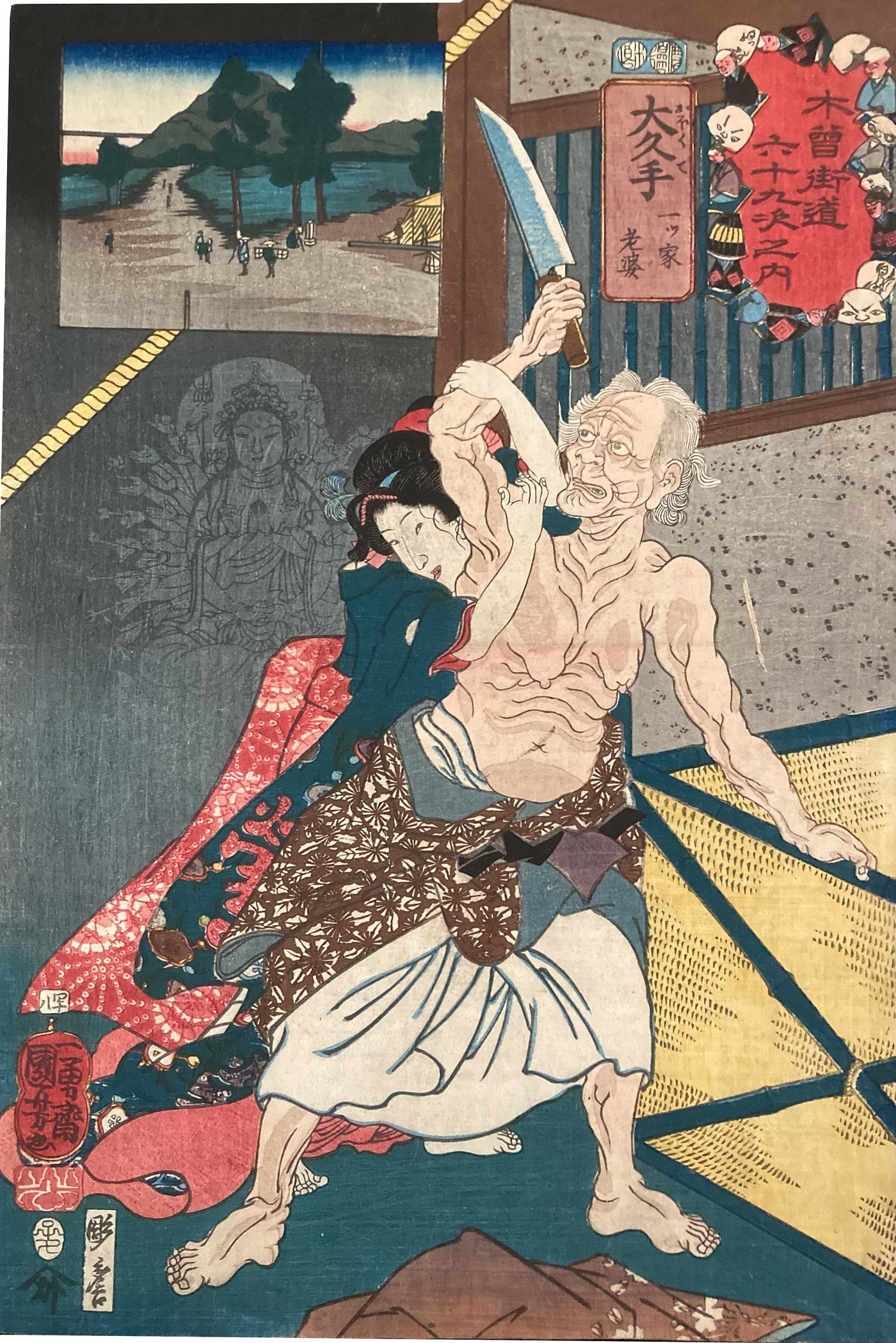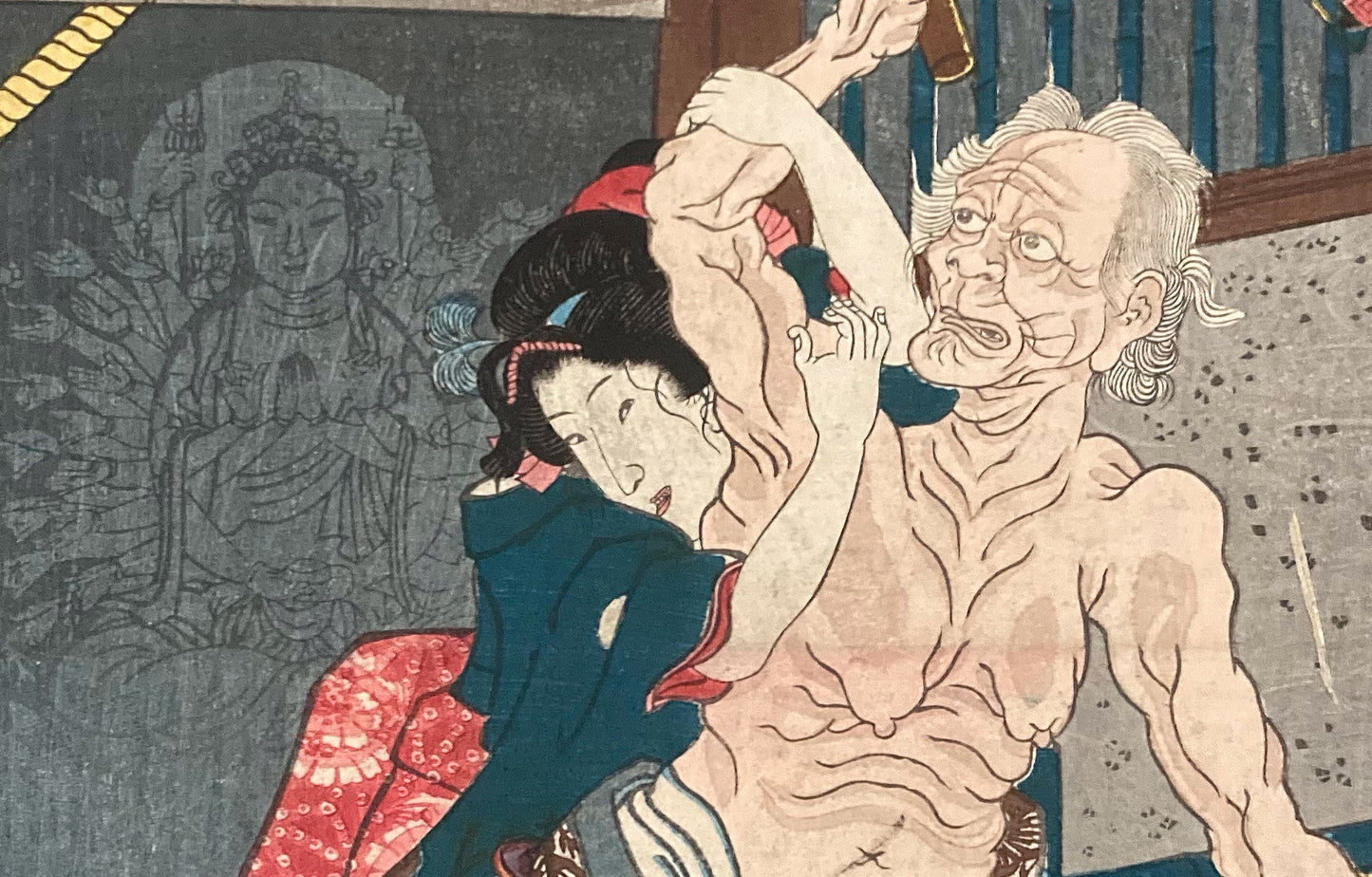Kuniyoshi - Okute - The Old Woman of the Lone House
Kuniyoshi - Okute - The Old Woman of the Lone House
Kuniyoshi
Thrilling scene of "The Old Woman of the Lone House" (Hitotsuya rōba 一ツ家老婆), from the series Sixty-nine Stations of the Kisokaidō Road.
"In Japanese literature, the horror-story trope of a lonely house on a desolate moor, where unwary travelers meet terrible fates, goes back at least to the eleventh century, when the legend of Kurozuka in the northern province of Mutsu was mentioned in a poem in the anthology Collected Poetic Gleanings (Shūiwakashū). The story of a murderous old woman who is really a demon was later dramatized in the nō play called Kurozuka or Adachigahara. The Edo-period version of the story, frequently illustrated by Kuniyoshi and his pupils, takes place at Asajigahara on the outskirts of Edo, not far from the great temple of the bodhisattva Kannon at Asakusa.
An evil old woman who lives in a solitary house on the moor takes in travelers and then murders them for their belongings. Her weapon is a large rock suspended in the dark rafters above the head of a sleeping victim, which falls when she cuts the rope that anchors it. The old woman's beautiful daughter reluctantly helps to lure travelers to their doom. One night, the intended victim is a young temple page boy so innocent (or in some versions of the story, so handsome) that the daughter cannot bear to see him killed and tries to stop her mother. The boy is then revealed as an incarnation of the Kannon of Sensō-ji Temple in Asakusa, who has appeared in order to end the killings.
Kuniyoshi depicts the struggle between mother and daughter, with the rope holding the stone cutting diagonally across the composition. The young traveler is not shown, but the shadowy figure of his true form, the merciful bodhisattva Kannon, hovers in the background. In Buddhist art, Kannon may appear in any of the thirty-three different forms. Kuniyoshi chose the thousand-armed Kannon, whose many limbs symbolize the divine ability to help in many different ways, because the name of Ōkute station sounds like 'many' (ōku) 'hands' (te).
"The series title border is composed of souvenirs of Asakusa: dolls called tondari-hane-tari that jump on bamboo springs, with covers in the shape of masks or umbrellas that pop off when they jump."
Quoted from: Utagawa Kuniyoshi: The Sixty-nine Stations of the Kisokaidō by Sarah E. Thompson, p. 112.
Here is the description of Ōkute from Hiroshige.org:
Past this post town, travellers walked on a flat road along the mountain with exposed rocks. From the Biwa Pass between Okute and Hosokute, they could see Mt. Ibuki, Mt. Hakusan and the Bay of Ise far away in the distance.
Publisher: Sakujirō
Carver's seal: Hori Takichi
Date seal: 1852, 7th mo.
Censors' seals: Mera and Watanabe
Condition: Great condition and color, not backed.
https://woodblockprints.org/index.php/Detail/Object/Show/object_id/1072
Couldn't load pickup availability



Guaranteed Authentic
All our original woodblock prints are guaranteed authentic as described and shown. We don't make any Photoshop enhancements or add filters to our print images. Please check the print images front and back carefully before purchase, if you'd like additional pictures feel free to contact us. If, after purchase, you're not satisfied for any reason, return your print for a full refund within 15 days.

